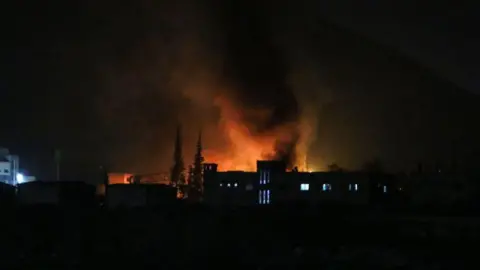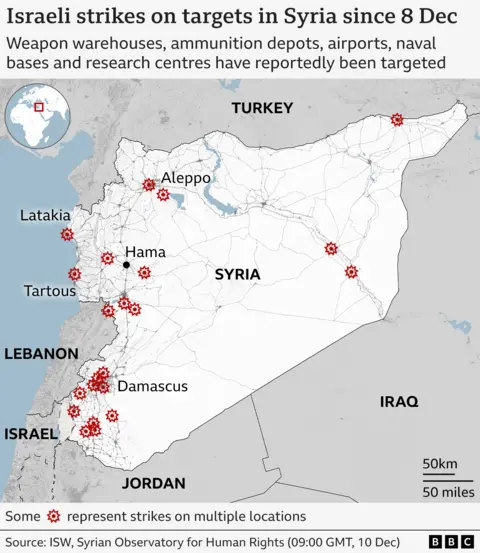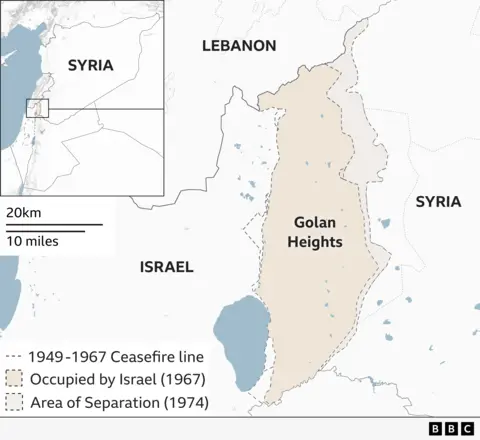Israel confirms attack on Syrian naval vessels

 Getty Images
Getty ImagesIsrael has confirmed that it has attacked Syrian ships.
The BBC has confirmed footage of an explosion at the port of Latakia in Syria, with images appearing to show extensive damage to ships and parts of the port.
The UK-based Syrian Observatory for Human Rights (SOHR) says it has documented more than 310 strikes by the Israel Defense Forces (IDF) since the fall of the Assad regime on Sunday.
Israeli warplanes have also reportedly carried out hundreds of airstrikes in Syria, including the capital, Damascus.
In a statement, Israeli Defense Minister Israel Katz said the IDF aims to “destroy capabilities that threaten the State of Israel”.
He added that the operation to destroy the Syrian ships was a “great success”.
Meanwhile, the IDF has confirmed that it has troops operating in Syrian territory beyond the buffer zone between Syria and the Israeli-controlled Golan Heights.
It added that its strikes were aimed at preventing weapons falling into the “hands of extremists” as Syria transitions to a post-Assad era.
SOHR reported that the attacks took place in Aleppo, Damascus and Hama, more than 60 of which happened overnight between Monday and Tuesday alone.
They targeted military facilities of the Syrian Army, including weapons depots, ammunition depots, airports, naval bases and research centers.
Reports say that many of the facilities that were hit were not only damaged, but destroyed.
Rami Abdul Rahman, the founder of SOHR, described the impact of the strikes as destroying “the entire strength of the Syrian army” and said that “Syrian lands are being violated”.

The IDF admitted that its forces had entered Syrian territory but told the BBC that reports of tanks approaching Damascus were “false”.
It said some soldiers had been placed inside Parting Point bordering the Israeli-occupied Golan Heights “and then a few more points”.
“If we say a few more points, we are talking about the Separation Zone, or the area around the zone,” IDF spokesman Nadav Shoshani told the BBC.
BBC Verify has released a photo of an IDF soldier standing a little more than half a kilometer across the demilitarized zone in the Golan Heights, inside Syria on a hill near the village of Kwdana.
on monday, The Israeli army released pictures of its soldiers crossing the Golan Heights occupied by Israel and entering the blockaded area in Syria where there are UN peacekeepers.
The IDF’s seizure of Syrian properties in the area is “a temporary measure until a proper plan is found,” Israeli Prime Minister Benjamin Netanyahu said Monday.
“If we can establish neighborly relations and peaceful relations with the new forces emerging in Syria, that is our desire. But if we don’t do that, we will do whatever is necessary to protect the State of Israel and Israel’s border,” he said. Monday.
Turkey’s Foreign Ministry condemned Israel’s entry into the safe zone, accusing it of “occupationalism” at a “critical time, when an opportunity has arisen to achieve the peace and stability that the Syrian people have longed for for many years”.
This buffer zone, also known as the Separation Zone, was established as part of Israel’s 1974 ceasefire agreement with Syria to keep Israeli and Syrian forces separate, following Israel’s previous occupation of the Golan Heights.
Israel gained independence from the Golan in 1981. This move was not universally recognized, although the US did so jointly in 2019.

Asked about the IDF strikes on Monday night, Israeli Foreign Minister Gideon Saar said Israel was only concerned with protecting its own citizens.
“That is why we are attacking strategic weapons systems such as, for example, the remaining chemical weapons or long-range missiles and rockets so that they do not fall into the hands of extremists,” he said.
On Monday, the UN chemical agency warned authorities in Syria to ensure that a suspected chemical weapons stockpile is safe.
It is not known where or how many chemical weapons Syria has, but it is believed that former President Bashar al-Assad was keeping stocks.
The Israeli attack comes after Syrian rebels captured the capital, Damascus, and he overthrew the regime of Bashar al-Assad over the weekend. He and his father had been in charge of the country since 1971.
Militants led by the Islamist opposition Hayat Tahrir al-Sham (HTS) entered Damascus early on Sunday, before appearing on state television to announce that Syria was now “free”.
Follow here for updates.
Source link




